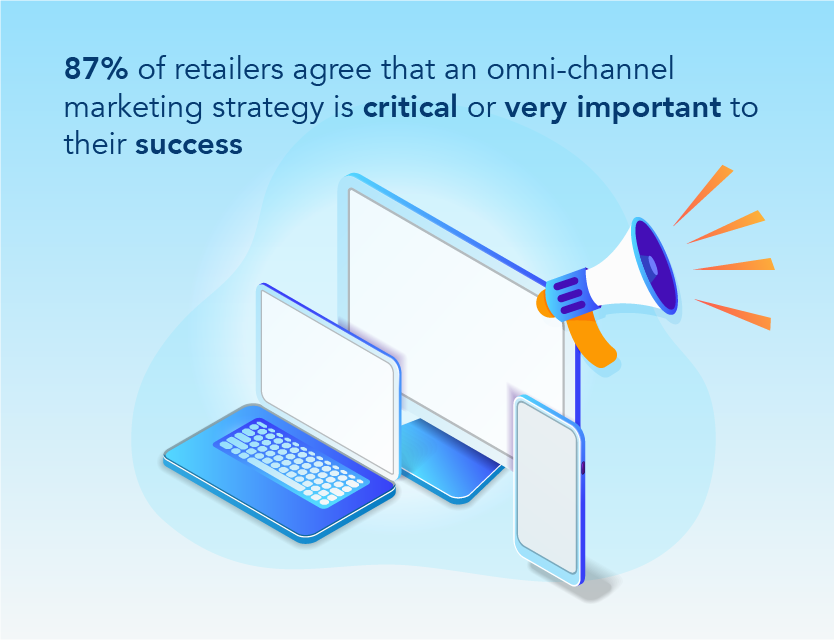

A whole new (omni-channel) world: creating cross-platform content

Are your customers multi-taskers? Lead them through a seamless journey with omni-channel content.
For many of us, owning multiple devices and using them at the same time is not uncommon in the slightest. How many times have you caught yourself browsing social media on your mobile phone, while also using your computer at the same time?
It’s not just you. In fact, 90% of tech users switch between an average of three devices a day to complete a task.
There are now more ways than ever to consume information easily on a range of devices. Just like food tastes, different people like to consume their content in different ways. It could be old-school written content, video, audio or the vast and growing range of graphical content like memes.
There are many platforms through which businesses can connect with their customers. But it’s not enough to just have a presence across multiple channels.
When we talk about omni-channel, we’re talking about elevating the consumer experience by offering a seamless journey through several platforms.
What is omni-channel marketing?

While multi-channel is about using multiple platforms to connect with your consumer base, omni-channel is about using all these platforms to create a single, integrated experience for your customer.
Especially with the way people consume content these days, it’s always a multidisciplinary experience. These various aspects work together to convey the same message by telling the same story, but in different ways and across different platforms.
A good omni-channel strategy should seamlessly connect multiple online platforms as well as the offline experience, while keeping the customer’s needs as its prime focus.
Creating omni-channel content

When it comes to omni-channel content, perhaps digital publishers do it best.
As with every other traditional newspaper, The New York Times (NYTimes) started out in print. But right now, it’s everywhere — you can find people from across the world (not just New York!) consuming content from the NYTimes via their desktop site, mobile apps, and various social media platforms.
The best part? You know it’s NYTimes the moment you see it.
Written
The omni-channel experience starts with its stunning, mobile-responsive website.
Of course, the apps are designed to fit mobile devices, but even the content of their main website is optimised for readership across different screen dimensions. No more pinching of your screen to zoom into the fine text when you’re trying to read an article on your mobile browser.
Not only that, you can save your favourite articles with their ‘Saved for Later’ feature, and access them through any device that is associated with your subscription.
If you don’t have time to scroll through every section on their website daily, you can also choose to have content that you’re most interested in delivered straight to your inbox for easy perusal. The Times has a huge variety of newsletters that you can subscribe to, covering topics that range from politics to technology to arts and culture.
Audio
As podcasts get more popular, the NYTimes has also expanded to producing audio content. Who would have expected a newspaper company to branch into audio? But nonetheless, they’ve done a good job.
To enable a more user-friendly experience, they’ve also included a native audio player that’s available on their site and built-into their apps. Users can now listen to their favourite Times podcasts without having to use a separate podcast app.
This feature will also allow audio to continue playing even if users navigate away from it, leave the app, or put their devices to sleep. Yes, you can now consume other kinds of content while you listen. Audio levels can be controlled within the app, with the device level controls, or even with an Apple Watch.
Immersive AR content on social media
Most recently, the Times has unveiled a new AR (Augmented Reality) lab that’s aimed at implementing a new, immersive digital journalism experience for readers.
A computer-generated image or animation is layered over a user’s view of the real world via filters and camera effects, in hopes of enabling readers to better understand what’s going on in the world in a personal way.
These effects can be accessed via the NYTimes’ Instagram profile page as well as across all their products. In fact, when this feature was first introduced, readers could launch the AR effect just by scanning the QR code featured in the paper with their smartphones.
“The whole point of this project is to really dig into how we can connect the physical world to layers of visual information,” says Dan Sanchez, an editor for emerging platforms at the New York Times. “If you’re an Instagram user, you can actually see those layers of information on top of the physical world, and you can actually manipulate them and remix them, and experience them on your own.”
Talk about providing an omni-channel experience that blends reality with digital!
What works on different channels?
The allure of omni-channel marketing lies in this premise — some people just prefer to consume certain content forms over others. For example, someone might read an article as opposed to watching a video about the same topic; someone else might prefer listening to the same content via an podcast instead.
To meet all these differing consumption patterns and preferences, there is a need to create diversified content on different mediums to ensure that you don’t alienate any one segment of your audience. The most basic way to decide what content types works best on which channel is by looking at the original functions of various social media networks — like how Twitter is primarily used for short text content and Instagram for visual content.
Alternatively, you can also look at the subject matter to see what’s big on various mediums and jump on the trends.
Edison Research’s Podcast Consumer Tracker found that comedy (36%) was the most popular podcast genre for the third quarter of 2019, followed by news (23%), and society and culture (22%). If we’re talking about YouTube, some of the most popular video types are product reviews, as well as tutorials.
Tips and best practices for different devices
Mobile apps and tablets
We live in a world that’s dominated by mobile, and of course creating mobile-first content is a must.
Text
To optimise text for mobile readership, it all starts with the headline. Keep it to about 6 to 7 words — according to CoSchedule, those get the highest amount of click-throughs. You might also want to include a standfirst or a summary right after your headline, so that readers know what to expect from your article. Consider it a TLDR (“Too Long, Didn’t Read”).
Most importantly, always remember to split your text content up into smaller chunks (use headers) so it looks less intimidating and much more easily digestible on a smaller screen. You don’t want your readers to leave your site right away!
Visuals
Images, illustrations and infographics are also a brilliant way to make your content more ‘readable’ on mobile devices. After all, mobile or not, no one really wants to read a whole wall of plain text. Add a visual punch to keep your content memorable — people are 65% more likely to remember information that has an accompanying visual.
When it comes to creating visual-heavy content for mobile applications like Instagram, pay attention to the image specifications, including aspect ratios and resolution. Not only are wrongly-sized images an eyesore, they also reflect poorly on your brand.
If you’re uploading an Instagram story, or a Facebook story, make them vertical and full-screen (1080px by 1920px, aspect ratio 9:16) to give your viewers the full immersive experience. And no, we don’t mean using a horizontal video and layering a border around it to fill the excess space.
You can also consider using carousels to create a seamless viewing experience: if you have a long horizontal image, try splitting it up into different square frames (you can have up to 10) that scroll uninterrupted on an Instagram post. Alternatively, you can include continuous elements across your carousel frames so that they slide across your screen harmoniously.
Smart speakers
Siri, Alexa, Google… The list goes on. With a booming smart speaker market, it’s important to figure out exactly what kind of smart speakers your consumers are primarily on. While they might seem similar on the surface, each device has their own set of unique functions.
For example, Alexa has a Flash Briefing function where it can provide bits of information such as quick blog updates, a news item, or even a daily joke. And it’s on you as a content creator to create a Flash Briefing Skill API to provide your Alexa customers with your content updates.
Since everything is audio-activated, try to keep content short, sweet and to-the-point. Research indicates that FAQ-style content, articles, local information, and longtail keywords get top billing in this market.
It’s also important to cut the jargon. In the end, audio content should lean more towards the conversational side to make for easy listening and comprehension.
When people are speaking to their voice assistants, they typically use questions or short phrases. A good gauge would be the 5Ws and 1H: What? Who? Where? When? Why? How?
You might want to rephrase your audio content so that it easily answers these questions, so you’ll pique the attention of the smart assistants.
Repurposing with a good content strategy

Luckily for you, creating omni-channel content doesn’t mean having to create original assets for every single platform and device — you really just need one.
Repurposing your content is a smarter and more effective way of ensuring that your audience gets what is essentially the same kind of information but through various mediums.
A video interview for example, could be turned into a podcast, which can then be transcribed and rewritten into an article. The main points of the video could also be summarised and turned into an infographic that is easily shared on social media sites.
When you’re repurposing content, it is important to be constantly testing, tracking, and responding to your customers’ needs and feedback.
Monitoring customer activity across all your digital platforms is crucial. When you’re able to gain insight on customer engagement, clicks, and turnover rates, it’s then much easier to refine and streamline your content offerings. Adopting A-B testing will prove extremely helpful in this regard.
You should also segment and categorise all these data according to common characteristics — you can even go ahead and create buyer personas. When your customer base is segmented, you can better tailor your content to the specific audience groups, so your offerings always stay relevant.
A seamless experience
Creating omni-channel content is a valuable way to make your customers feel appreciated by giving them a consistent, convenient, and personalised customer experience. No matter the kind of content they want to consume, regardless of the medium, you will be ready to meet your consumers wherever they are.
Although it might seem incredibly daunting to have to keep up with multiple channels (both online or offline), don’t let your fears hold your business back.
Let us help you get started in creating omni-channel content. Reach out to our CEO Simon Kearney at [email protected].
Read more from Click2View:
- A whole list of content marketing buzzwords that you need to know.
- What makes content stick out in the minds of your audience?
- Remote video recording is a breeze with these platforms.
Sign up to our newsletter for a weekly update on the latest content marketing news. Don’t forget to subscribe to our YouTube channel too!
Click2View is Southeast Asia’s premiere full-service independent B2B content marketing agency servicing clients like Microsoft, Google, Visa, Prudential, and the Lee Kuan Yew School of Public Policy.








